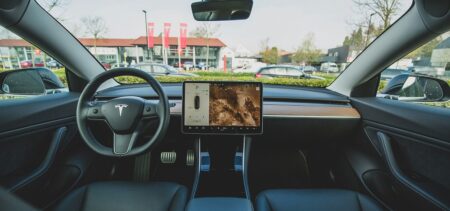Self-driving cars used to be the stuff of legends, featured only in science fiction and fueling the dreams of car enthusiasts and technology lovers everywhere (anyone else remember KITT from Knight Rider?). But in 2023, autonomous cars are not only a real possibility, but they’re also gaining in popularity. An industry currently valued at just over $120 billion, the proliferation of self-driving cars is an exciting leap forward in automation development.
For technologists, the interesting question is, what technology drives autonomous cars? What are the safety parameters of this, and when will it be commercially available? It’s an exciting time for startups and automotive companies, as the race to safely develop autonomous vehicles is revving up! Between legacy car companies and tech startups, the investment into autonomous vehicle (AV) technology is a lucrative, societal game-changer, and perhaps the most significant innovation since the wheel. Here are the latest updates in the AV tech landscape!
AV Technology in 2023
With each passing year, we’re inching closer to the reality of widespread commercial availability of autonomous vehicles. Predictions on when this is fully realized suggest 2035 as the earliest we can expect to walk into a showroom and have your car drive you out. Major upgrades in safety and technology are still required to get to level five in vehicle automation, according to the Society of Automotive Engineers (SAE), which has established the six levels of vehicle automation. Understanding the automation milestones is a good place to start when grappling with the technology behind these vehicles.
According to the SAE, Level zero categorizes manual cars where none of the features are automated, and the driver is fully in control. This category applies to the majority of vehicles on the road. While there may be a few features like emergency braking, which don’t require human input, the cars at level 0 are operated solely by the driver. Level one takes a small technological leap, introducing driver assistance systems like cruise control, but the driver is still primarily controlling the vehicle. Cars with advanced driver assistance systems (ADAS) form part of level two, where the vehicle can control steering and accelerating/braking functions. Tesla’s Autopilot and Cadillac’s Super Cruise Systems are two of the most notable examples of level two partial automation; while the car can operate certain functions, the driver needs to remain alert and in control at all times.
Level three is where autonomous vehicle technology really starts to get interesting! With software features like environmental detection, cars at this level are largely autonomous, but still require driver attention. Autonomous vehicles in level three can sufficiently control aspects of driving with technology like lane assist, parking assistance, and sensors to measure the distance between cars in the vicinity. Mercedes Benz’s Drive Pilot is a level 3 AV software system that will be commercially available in early 2024, making the German brand the only automaker with government approval in the United States at this level.
Levels four and five categorize vehicles with high automation and full automation, respectively. An autonomous vehicle categorized at level four requires very little human input, and the car itself takes measures to intervene in the event of a system or hardware malfunction. At level five, the car is completely automated, and human interaction and/or attention are not needed at all. This is the future automakers are working toward, although there is still significant work to be done in developing the infrastructure, code of ethics, and legislation to support these vehicles and their place on the road.
LiDAR Technology
Short for Light Detection and Ranging, LiDAR is a key element in autonomous vehicles used for distance sensing. LiDAR is already present in level two AVs, but there are significant challenges with developing a cost-effective method of deploying this optical technology at scale, which is the catalyst for the commercialization of level three autonomous vehicles. LiDAR works by emitting a laser light from a source (transmitter), which is reflected by objects surrounding the source. Distance is judged based on how long it takes reflected light to bounce back to the receiver (time-of-flight). Major car manufacturers and tech startups are investing in research and development to improve and popularize LiDAR, with the general understanding that this technology is at the basis of creating autonomous vehicles—certainly a key element to break into level three. Developing LiDAR is a capital-intensive task, but with a market size valued at $1.5 billion, there’s plenty of gold at the end of the rainbow for companies with an appetite for risk.
Partnerships between car companies and startups are gaining in popularity, and the collaboration between BMW and Innoviz is a perfect example of this. With stiff competition to leapfrog into level three, where Mercedes currently holds the monopoly, collaborating with hyper-specialized LiDAR technology companies gives car manufacturers a competitive edge. It’s an exciting, ambitious project all around; companies will have to jump through stringent ethical, legal, and compliance hoops before their wheels hit the road, but the development in this space is nothing short of futuristic!
Human Interaction Is Still Needed – for Now
Since 2020, almost all motor vehicle manufacturers have included semi-autonomous components in their cars. While these features can automate certain aspects of driving, car warning systems will always advise drivers to keep their hands on the steering wheel and attention on the road at all times. While we’re getting closer to seeing the commercialization of AVs, industry experts warn that there’s still a great deal more to be done in terms of safety, with even semi-autonomous vehicles presenting concerns.
The fatal collision involving a Tesla Model S on “autopilot” mode in 2016 is one of the most high-profile accidents involving a semi-autonomous (Level two) vehicle. The U.S. Department of Transportation launched an investigation under its National Highway Traffic Safety Administration to determine the cause of the collision. The report concluded that semi-autonomous features were used, including autopilot mode and the autonomous emergency braking system (AEB), and neither the hardware nor the software malfunctioned. Ultimately, driver awareness was still required, and in this unfortunate instance, the driver was found to be negligent.
It can be tempting to mentally switch off or lose focus in a car that boasts safety features like adaptive cruise control, autonomous emergency braking, lane departure warnings, lane keeping assistance, and collision warnings. However, even in level three AVs, human intervention and attention is needed to keep cars safe on the road. The Mercedes Drive Pilot (which allows for eyes off the road and hands off the wheel) can only be used in ideal conditions. These include a vehicle present ahead of your car, clear weather conditions, daylight, reasonable road conditions, and visible markings.
But the safety doesn’t stop short of optimal roadworthiness; when the operational design domain (ODD) is no longer met, Drive Pilot will warn drivers to start taking control of the vehicle again. This is a multi-sensory experience that starts off gently; first, the car will emit an audible chime while the steering wheel turns red, and then quickly builds to signal urgency; the seatbelt will begin to tug at the driver while the steering wheel and seat vibrate. In total, drivers are given approximately ten seconds to respond, failing which the car comes to a halt, the hazards are switched on, the doors are unlocked, and emergency services are notified.
Mercedes is incredibly confident in its technology and software capabilities, and to illustrate that, they have included in their purchase contract a liability clause that stipulates that they will assume liability for any incidents that occur in Drive Pilot mode (provided ODD conditions were met).
Conclusion
We’re steadily making progress toward a future with driverless cars, with an expectation that in early 2024, we should see the leap to level 3 commercialized, through Mercedes’ Drive Pilot. With tech startups partnering with automakers, we’re likely to see an acceleration into level 3 autonomous vehicles, as research and development focuses on making LiDAR deployment as efficient and cost-effective as possible. Cruising into the future of driverless cars will be a collaborative effort, with input required from legislators, transport authorities, ethics committees, and governments. Innovation in transport is nothing new, and while the 21st century has seen its fair share of upgrades in automotive technology, reaching the point of commercialization of level-five autonomous vehicles will be our generation’s equivalent to the invention of the wheel; one small step for man, and one smooth, automated ride for mankind!













































